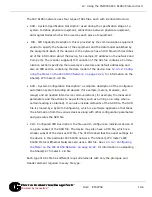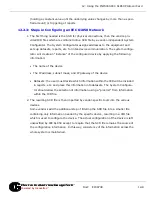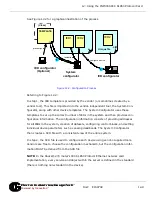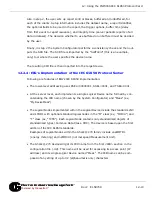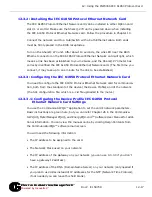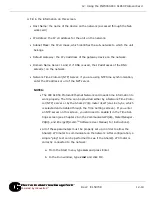
Doc
#
E159708
12-17
12: Using the INP300S IEC 61850 Protocol Card
Electro
Industries/GaugeTech
™
Powered by Innovation™
12.3.2: Installing the IEC 61850 Protocol Ethernet Network Card
The IEC 61850 Protocol Ethernet Network card can be installed in either Option card
slot #1 or slot#2. Make sure the Shark® 270 unit is powered down when installing
the IEC 61850 Protocol Ethernet Network card. Follow the procedure in Chapter 10.
Connect the network card to a Hub/Switch with a Cat5 Ethernet cable. Both ends
must be firmly placed in the RJ45 receptacles.
Turn on the Shark® 270 unit. After about 10 seconds, the Link LED near the RJ45
Ethernet connector on the IEC 61850 Protocol Ethernet Network card will light, which
means a link has been established to your network, and the Shark® 270 meter has
correctly identified the IEC 61850 Protocol Ethernet Network card. (The first time you
connect, it may take up to one minute for the link to be established.)
12.3.3: Configuring the IEC 61850 Protocol Ethernet Network Card
You need to configure the IEC 61850 Protocol Ethernet Network card for communica-
tion, both from the standpoint of the device (the Device Profile) and of the network
(the SCL configuration file, which is a .cid file uploaded to the meter.)
12.3.3.1: Configuring the Device Profile IEC 61850 Protocol
Ethernet Network Card Settings
You use the CommunicatorPQA™ application to set the card’s network parameters.
Basic instructions are given here, but you can refer Chapter 26 in the
torPQA®, MeterManagerPQA®, and EnergyPQA.com
TM
Software User Manual
for addi-
tional information. You can view the manual online by clicking Help>Contents from
the CommunicatorPQA™ software main screen.
You will need the following information:
• The IP address to be assigned to the card.
• The Network Mask used on your network.
• The IP address of the Gateway on your network (you can use 0.0.0.0 if you don’t
have a gateway IP address).
• The IP address of the DNS (Domain Name Server) on your network (only needed if
you plan to use URLs instead of IP addresses for the NTP (Network Time Protocol);
if not needed you can leave this field blank).




